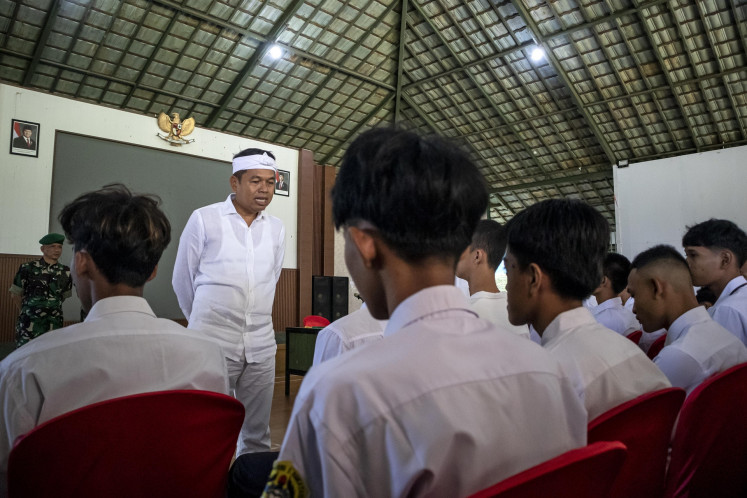NAOMI SRIKANDI: Making art matter to the public
Theater is more than just a childhood game or room for self-expression for playwright and director Naomi Srikandi
Change text size
Gift Premium Articles
to Anyone

T
heater is more than just a childhood game or room for self-expression for playwright and director Naomi Srikandi.
Above all, the artist believes that performance is a medium that she can use to engage with society’s problems.
The Yogyakarta-based artist has been in touch with the art world since she was a baby. She spent her first five years living at a theater company run by her late father, the legendary poet Rendra.
“Since I woke up until I went to sleep, I was exposed to art,” recalled the woman, who made her acting debut when she was still four.
Even after her mother and father separated, Naomi remained a young girl close to art. Naomi’s interaction with art remained intact with support from her mother’s royal family, who upheld art and cultural values.
“Art became part of my daily life, just like eating, drinking and playing. It became part of my childhood games,” she recalled.
That habit became her way of life. During her time in school, Naomi said she remembered herself as the student who prioritized extracurricular activities in art than academic performance.
“I remember going to school for art, not for studying,” said the woman, who eventually left college for a career in the theater.
The best actress at the 1993 Yogyakarta High School Theater Festival admitted her father was the one she looked up to in her career as an artist.
Despite an awkward father-daughter relationship after the divorce, Naomi said she still secretly updated herself with the latest news from her father to fill the absence of the man’s figure in her life.
It was from her father’s articles, poetry and public speeches that Naomi finally discovered what it meant to be an artist. “I learned from his artworks that art is not only about craftsmanship. Not about how good our dancing is, but what we are dancing for,” said Naomi, who admitted that such enlightenment came during what she called a crucial age, when she was between 10 and 15 years old.
More than 20 years later, the question remains in Naomi’s heart and has become a guide in her work as
an artist.
While most artists are busy with their work to get public acknowledgement, Naomi goes beyond that.
“Performance art is my way to relate to my surroundings. My art is a form of art that is designed, discovered and initiated to see reality in society,” Naomi said.
Her latest work, Goyang Penasaran (Obsessive Twist), reflects that approach and how she tries to engage with the public through gender issues.
Inspired by gender expert Intan Paramaditha’s short story, Naomi created a theater performance that offers a critical look at the issue of sexuality.
Naomi explained that exploring gender issues had always been of interest to her. And her status as a female director seems to have given her the sensitivity and the fluency to talk about the subject.
Naomi’s consistency in dealing with gender can be seen from her two previous theater projects, Shakuntala (2007), a monologue adapted from a character in the bestselling novels Saman and Larung, and Medea Media (2010), a loose adaptation of the Greek play Medea that brings the same theme of sexuality to the stage.
Naomi thinks it is important to discuss gender further in her art due to the theme’s strategic position within society’s power relations.
“This issue has become important in part in social, political and religious spheres … Sexuality is a theme that has been used by various parties, be it religious people or by the industry to seize power. It has been exploited everywhere,” Naomi said.
Through her latest work, Goyang Penasaran, Naomi tries to bring the reality of sexuality in society into a larger context, including its complex relations to politics and religion. Naomi composed the message in a new and fresh way so viewers can also relate to the complicated problem.
Writing the script with Intan, Naomi aimed to find a new style in theatrical performance that could further involve the public in the discussion delved into on stage.
Naomi told The Jakarta Post in a recent interview that she believed her job as an artist was to design aesthetic mediums that can relate to people’s problems, using her own father’s words about creating beauty to face the challenges of the times, or, in short, making art matter to the public.
But Naomi hopes her art also covers other subjects, not only gender.
Apart from her father, the big influence on Naomi’s career came from colleagues and friends in the Yogyakarta-based theater company Teater Garasi.
Naomi joined the group when she was still a student at Gadjah Mada University back in 1994.
She started off as an actress and was involved in some acclaimed productions, including the Waktu Batu project that took her to Singapore, Berlin, Germany and Tokyo to perform. Her CV also mentions her involvement in various international collaborations with art communities in several countries.
Her career continued to expand through the Artist Collective initiative run by the theater company to encourage artists to develop their talents by creating personal projects.
Under the program, Naomi made her directorial debut with Shakuntala in 2007. Performed in Jakarta and Yogyakarta, the show introduced Naomi to her passion for directing. She followed her passion with a second project, Medea Media, which tried to discuss the horrid relations between the media and women through the depiction of gender-based viewings of Indonesian television shows.
Naomi’s second project received funding support from the respected art foundation Kelola. The foundation awarded Naomi the Empowering Woman Artist award in 2010 to acknowledge her role as a young emerging female director in the country.
Having had success on stage and behind the curtain, Naomi said her ultimate ambition was to establish a room of creation that she can continuously use to engage with her surroundings.
Knowing that her mission as an artist is to relate to the public, her creative process is not something that many artists will adopt.
“I don’t isolate myself. I embrace my daily life. I just become a normal person, who also goes to parent’s meeting at my children’s school. Just being an ordinary person,” the mother of two explained of
her unique approach to the creative process.
Naomi seems to be walking the talk, proving that nothing is better for an artist trying to relate to the public than becoming part of society in the process of creation.









